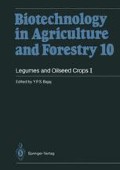Abstract
Indigofera is a large genus containing some 800 species within the family Leguminosae. As a genus it is best known for the indigo plant, from which the dye indigo is obtained. Many of the species are annual or perennial herbs, but some are shrubs, whilst others grow to small trees. Members of the genus are widespread in tropical and subtropical areas, particularly the Sino-Indian region, but they are also found in the tropics of both America and Africa. Indeed, the genus Indigofera is one of the largest and most widely distributed in South Africa. Many of the species are adapted to semi-dry areas, and species are characteristically found in open and waste places, along roadsides and in grass and brushwood (Allen and Allen 1981).
Access this chapter
Tax calculation will be finalised at checkout
Purchases are for personal use only
Preview
Unable to display preview. Download preview PDF.
References
Allen ON, Allen EK (1981) The Leguminosae. A source book of characteristics, uses and nodulation. Univ Press, Wisconsin
Aylward JH, Court RD, Haydock KP, Strickland RW, Hegarty MP (1987) Indigofera species with agronomic potential in the tropics; rat toxicity studies. Aust J Agric Res 38: 177–186
Bean WJ (1970) Trees and shrubs hardy in the British Isles. 8th Edition, Murray, London
Bharal S, Rashid A (1979) Regeneration of plants from tissue cultures of the legume Indigofera enneaphylla Linn. Z Pflanzenphysiol 92: 443–447
Bharal S, Rashid A (1984) Growth of free-cell suspension and plantlet regeneration in the legume Indigofera enneaphylla Linn. Biol Plant Praha 26: 202–205
Christie GS, Madsen NP, Hagerty MP (1969) Acute biochemical changes in rat liver induced by the naturally occurring amino acid indospicine. Biochem Pharmacol 18: 693–700
Evans PK, Taylor E, Stewart CE (1986) Organogenesis on cultured leaf explants of a legume, Indigofera potaninii. In: 6th Int Congr plant tissue and cell culture. Abstr, Univ Minnesota, Minneapolis, p 178
Gamborg OL, Miller RA, Ojima K (1968) Nutrient requirements of suspension cultures of soybean root cells. Exp Cell Res 50: 151–158
Hegarty MP, Peterson PJ (1973) Free amino acids, bound amino acids, amines and ureides. In: Butler GW, Bailey RW (eds) Chemistry and biochemistry of herbage, vol 1. Academic Press, London, pp 1–62
Howell EC, Stewart CB, Evans PK (1987) Tissue culture and plant regeneration of Indigofera potaninii Craib. J Plant Physiol 128: 259–269
Martin-Leake H (1975) An historical memoir of the indigo industry of Bihar. Econ Bot 29: 361–371
Murashige T, Skoog F (1962) A revised medium for rapid growth and bioassay with tobacco tissue cultures. Physiol Plant 15: 473–497
Peattie DC (1936) Cargoes and harvests. Appleton-Century, New York
Rembert DH (1979) The indigo of commerce in colonial North America. Econ Bot 33: 128–134
Rhoades HL (1976) Effect of Indigofera hirsuta on Belonolaimus longigaudatus, Meloidogyne incognita, and M. javanica and subsequent crop yields. Plant Dis Rep 60: 384–386
Rhoades HL, Forbes RB (1986) Effects of fallow, cover crops, organic mulches, and fenamiphos on nematode populations, soil nutrients, and subsequent crop growth. Nematropica 16: 141–151
Schwenk FW (1980) Callus formation from mechanically isolated soybean cotyledonary cells. Plant Sci Lett 17: 437–442
Uchimiya H, Murashige T (1974) Evaluation of parameters in the isolation of viable protoplasts from cultured tobacco cells. Plant Physiol 54: 936–944
Usher G (1974) A dictionary of plants used by man. Constable, London
Widholm JM (1972) The use of fluorescein diacetate and phenosafranine for determining viability of cultured plant cells. Stain Technol 47: 189–194
Author information
Authors and Affiliations
Editor information
Editors and Affiliations
Rights and permissions
Copyright information
© 1990 Springer-Verlag Berlin Heidelberg
About this chapter
Cite this chapter
Evans, P.K. (1990). Indigofera spp.. In: Bajaj, Y.P.S. (eds) Legumes and Oilseed Crops I. Biotechnology in Agriculture and Forestry, vol 10. Springer, Berlin, Heidelberg. https://doi.org/10.1007/978-3-642-74448-8_30
Download citation
DOI: https://doi.org/10.1007/978-3-642-74448-8_30
Publisher Name: Springer, Berlin, Heidelberg
Print ISBN: 978-3-642-74450-1
Online ISBN: 978-3-642-74448-8
eBook Packages: Springer Book Archive

